- Joined
- Oct 22, 2014
- Messages
- 9,929
The S&B Klassik is Schmidt’s basic line of hunting scopes. Historically they have generally worked without much fuss for how most hunting scopes are used. This one is the fixed power 8x56mm made in Hungary model. According to S&B there are no differences other than country of manufacture between the German and Hungarian versions- and I have personally seen no difference.
Scope and Weight:
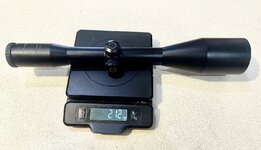
Turrets:

Elevation and windage turrets are their “Klassik CT” turret system- standard capped turrets except for the position indicator (small silver screw) that shows were you are in total travel.
Reticle:
This reticle is the A7 model-
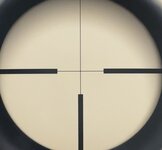
Parallax:
Parallax is fixed at 100m. I have not noticed any issues with parallax out to 400m with this scope.
Initial thoughts:
This scope is marketed as a specialized scope for hunting out of blinds or stands in very low light, or nighttime hunting. It is a rather large scope, however excels in this role. Those who have not seen or used one of the bigger fixed power “alpha” scopes do not grasp how good they are in extremely bad light.
Zeroing:
Initial zeroing was completed without much issue other than no measuring tape (reticle) in the scope.
Proofing the rifle and this lot of ammo was done using another scope, the 30 round group extreme spread was 1.37” at 100 yards.
The top dot. The “BS” is the first shot after boresight and and getting on paper at 25y. Then four rounds. Adjusted right .2 mil, and then ten rounds on bottom. Adjusted down .2 mils and went to the drop eval.
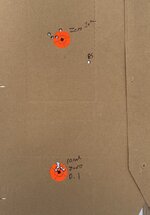
“Tracking”
Other than zeroing, not conducted.
Drop evaluation:
For an explanation see- Scope Field Eval Explanation and Standards
The “test” consists of three 18” drops on a mat- one left/right/top with a shot to check zero after each drop. Then the exact same thing repeated from 36”. Then three drops on all three sides for nine drops on the last part- 15 drops total. This is not “abuse”. The 18” drops are a joke really. The 36” start showing something. And when a scope make/model consistently goes through the whole thing without losing zero, failures in actual use are almost unheard of.
This one was conducted on packed, semi crusted snow.
The first 18” drop on left side showed no POI shift-
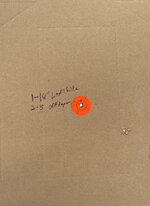
However the right side drop did cause a loss of zero totally off the 18” wide target. The top drop was off as well.
Initially 18 in-lbs was used on the ring caps, however could be seen that the scope slipped. So the scope and mounts were disassembled, and reassembled using 20 in-lbs, and rezeroed.
Center dot again-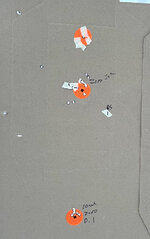
The zero was .2 mil low when the drop eval was started. This time all rounds impacted with baseline group size.
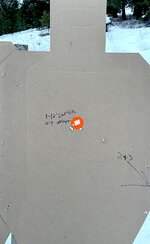
Results:
The scope works. 18 in-lbs is the standard that I use for scopes as a starting point, and I right inline with most recommended torque values. However, I generally use 20-22 in-lbs because of scope slippage. After remounting, the scope functions and adjusts as it should and it holds zero.
Being that it passed everything, I will give my subjective views as far as eyebox, image quality, and overall use and feel in the next posts.
Scope and Weight:

Turrets:

Elevation and windage turrets are their “Klassik CT” turret system- standard capped turrets except for the position indicator (small silver screw) that shows were you are in total travel.
Reticle:
This reticle is the A7 model-

Parallax:
Parallax is fixed at 100m. I have not noticed any issues with parallax out to 400m with this scope.
Initial thoughts:
This scope is marketed as a specialized scope for hunting out of blinds or stands in very low light, or nighttime hunting. It is a rather large scope, however excels in this role. Those who have not seen or used one of the bigger fixed power “alpha” scopes do not grasp how good they are in extremely bad light.
Zeroing:
Initial zeroing was completed without much issue other than no measuring tape (reticle) in the scope.
Proofing the rifle and this lot of ammo was done using another scope, the 30 round group extreme spread was 1.37” at 100 yards.
The top dot. The “BS” is the first shot after boresight and and getting on paper at 25y. Then four rounds. Adjusted right .2 mil, and then ten rounds on bottom. Adjusted down .2 mils and went to the drop eval.

“Tracking”
Other than zeroing, not conducted.
Drop evaluation:
For an explanation see- Scope Field Eval Explanation and Standards
The “test” consists of three 18” drops on a mat- one left/right/top with a shot to check zero after each drop. Then the exact same thing repeated from 36”. Then three drops on all three sides for nine drops on the last part- 15 drops total. This is not “abuse”. The 18” drops are a joke really. The 36” start showing something. And when a scope make/model consistently goes through the whole thing without losing zero, failures in actual use are almost unheard of.
This one was conducted on packed, semi crusted snow.
The first 18” drop on left side showed no POI shift-

However the right side drop did cause a loss of zero totally off the 18” wide target. The top drop was off as well.
Initially 18 in-lbs was used on the ring caps, however could be seen that the scope slipped. So the scope and mounts were disassembled, and reassembled using 20 in-lbs, and rezeroed.
Center dot again-

The zero was .2 mil low when the drop eval was started. This time all rounds impacted with baseline group size.

Results:
The scope works. 18 in-lbs is the standard that I use for scopes as a starting point, and I right inline with most recommended torque values. However, I generally use 20-22 in-lbs because of scope slippage. After remounting, the scope functions and adjusts as it should and it holds zero.
Being that it passed everything, I will give my subjective views as far as eyebox, image quality, and overall use and feel in the next posts.
